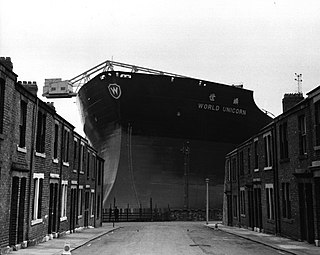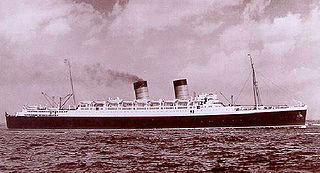Two ocean liners of the Cunard Line have been named RMS Mauretania, after the ancient territory of Mauretania:
- RMS Mauretania (1906), launched in 1906 and in service until 1934
- RMS Mauretania (1938), launched in 1938 and scrapped in 1965
Two ocean liners of the Cunard Line have been named RMS Mauretania, after the ancient territory of Mauretania:
Queen Victoria has been the name of several ships:

Turbinia was the first steam turbine-powered steamship. Built as an experimental vessel in 1894, and easily the fastest ship in the world at that time, Turbinia was demonstrated dramatically at the Spithead Navy Review in 1897 and set the standard for the next generation of steamships, the majority of which would be turbine powered. The vessel is currently located at the Discovery Museum in Newcastle upon Tyne, North East England, while her original powerplant is located at the Science Museum in London.

RMS Mauretania was an ocean liner designed by Leonard Peskett and built by Wigham Richardson and Swan Hunter for the British Cunard Line, launched on the afternoon of 20 September 1906. She was the world's largest ship until the launch of RMS Olympic in 1910. Mauretania became a favourite among her passengers. She captured the eastbound Blue Riband on her maiden return voyage in December 1907, then claimed the westbound Blue Riband for the fastest transatlantic crossing during her 1909 season. She held both speed records for 20 years.

Swan Hunter, formerly known as Swan Hunter & Wigham Richardson, is a shipbuilding design, engineering, and management company, based in Wallsend, Tyne and Wear, England.

The second RMS Mauretania was an ocean liner that was launched on 28 July 1938 at the Cammell Laird yard in Birkenhead, England, and was completed in May 1939. She was one of the first ships built for the newly formed Cunard-White Star company following the merger in April 1934 of the Cunard and White Star Line. On the withdrawal of the first Mauretania in 1935, to prevent a rival company using the name and to keep it available for the new liner, arrangements were made for the Red Funnel paddle steamer Queen to be renamed Mauretania in the interim.
Mauretania was an ancient Berber kingdom.

Sir Arthur Henry Rostron, KBE, RD, RNR was a British merchant seaman and a seagoing officer for the Cunard Line. He is best remembered as the captain of the ocean liner RMS Carpathia when it rescued hundreds of survivors from the RMS Titanic after the latter ship sank in 1912 in the middle of the North Atlantic Ocean.
Maury may refer to:
Five ships and three shore establishments of the Royal Navy have borne the name HMS Caledonia after the Latin name for Scotland:
RMS or SS Empress of China may refer to one of these Canadian Pacific Steamship Company ocean liners:

Coral Eswyn Lyster, was a British-born Canadian author best known for writing extensively on the Canadian war bride experience. She also published articles on the Dieppe Raid in World War II, as well as a book on genealogy.

A four-funnel liner, also known as a four-stacker is an ocean liner with four funnels.

George Arbuthnot Burns, 2nd Baron Inverclyde was the owner of a Scottish shipping company. Burns was the elder son of John Burns, First Baron Inverclyde.
SS Brazil may refer to:
Arthur Tillotson Brown R. D., R. N. R., was a career sea officer who was the last captain of the first RMS Mauretania, and the first master of the second RMS Mauretania.
Bersagliere was the name of at least threec ships of the Italian Navy and may refer to:
Granatiere was the name of at least three ships of the Italian Navy and may refer to:
Clio was the name of at least three ships of the Italian Navy and may refer to:
Calliope was the name of at least two ships of the Italian Navy and may refer to: